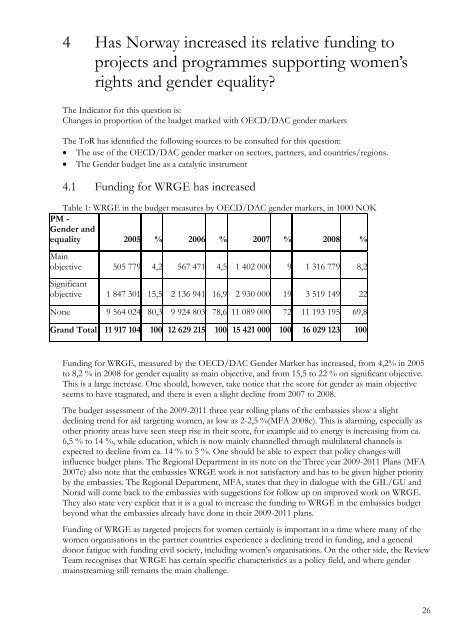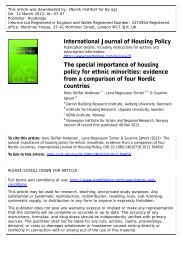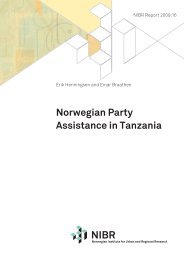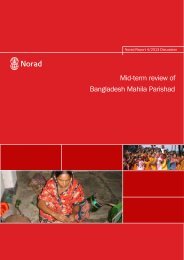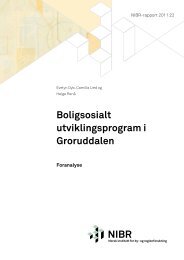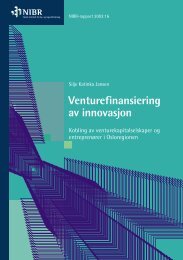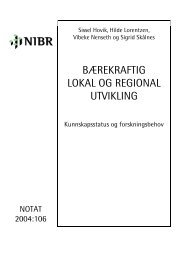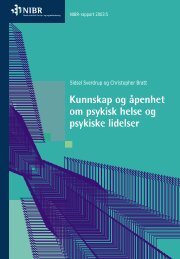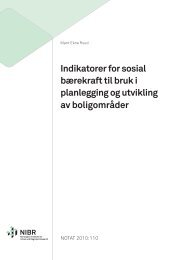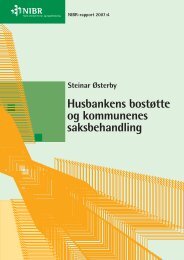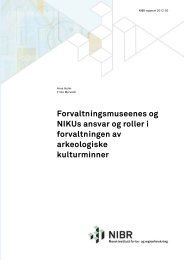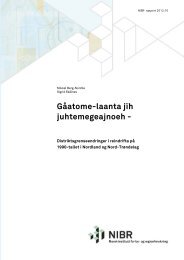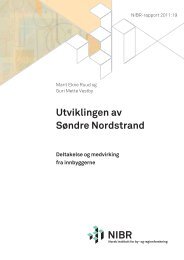4 Has Norway increased its relative funding toprojects and programmes supporting women’srights and gender equality?The Indicator <strong>for</strong> this question is:Changes in proportion <strong>of</strong> <strong>the</strong> budget marked with OECD/DAC gender markersThe ToR has identified <strong>the</strong> following sources to be consulted <strong>for</strong> this question: The use <strong>of</strong> <strong>the</strong> OECD/DAC gender marker on sectors, partners, and countries/regions. The Gender budget line as a catalytic instrument4.1 Funding <strong>for</strong> WRGE has increasedTable 1: WRGE in <strong>the</strong> budget measures by OECD/DAC gender markers, in 1000 NOKPM -Gender andequality 2005 % 2006 % 2007 % 2008 %Mainobjective 505 779 4,2 567 471 4,5 1 402 000 9 1 316 779 8,2Significantobjective 1 847 301 15,5 2 136 941 16,9 2 930 000 19 3 519 149 22None 9 564 024 80,3 9 924 803 78,6 11 089 000 72 11 193 195 69,8Grand Total 11 917 104 100 12 629 215 100 15 421 000 100 16 029 123 100Funding <strong>for</strong> WRGE, measured by <strong>the</strong> OECD/DAC Gender Marker has increased, from 4,2% in 2005to 8,2 % in 2008 <strong>for</strong> gender equality as main objective, and from 15,5 to 22 % on significant objective.This is a large increase. One should, however, take notice that <strong>the</strong> score <strong>for</strong> gender as main objectiveseems to have stagnated, and <strong>the</strong>re is even a slight decline from 2007 to 2008.The budget assessment <strong>of</strong> <strong>the</strong> 2009-2011 three year rolling plans <strong>of</strong> <strong>the</strong> embassies show a slightdeclining trend <strong>for</strong> aid targeting women, as low as 2-2,5 %(MFA 2008c). This is alarming, especially aso<strong>the</strong>r priority areas have seen steep rise in <strong>the</strong>ir score, <strong>for</strong> example aid to energy is increasing from ca.6,5 % to 14 %, while education, which is now mainly channelled through multilateral channels isexpected to decline from ca. 14 % to 5 %. One should be able to expect that policy changes willinfluence budget plans. The Regional Department in its note on <strong>the</strong> Three year 2009-2011 <strong>Plan</strong>s (MFA2007c) also note that <strong>the</strong> embassies WRGE work is not satisfactory and has to be given higher priorityby <strong>the</strong> embassies. The Regional Department, MFA, states that <strong>the</strong>y in dialogue with <strong>the</strong> GIL/GU and<strong>Norad</strong> will come back to <strong>the</strong> embassies with suggestions <strong>for</strong> follow up on improved work on WRGE.They also state very explicit that it is a goal to increase <strong>the</strong> funding to WRGE in <strong>the</strong> embassies budgetbeyond what <strong>the</strong> embassies already have done in <strong>the</strong>ir 2009-2011 plans.Funding <strong>of</strong> WRGE as targeted projects <strong>for</strong> women certainly is important in a time where many <strong>of</strong> <strong>the</strong>women organisations in <strong>the</strong> partner countries experience a declining trend in funding, and a generaldonor fatigue with funding civil society, including women’s organisations. On <strong>the</strong> o<strong>the</strong>r side, <strong>the</strong> <strong>Review</strong>Team recognises that WRGE has certain specific characteristics as a policy field, and where gendermainstreaming still remains <strong>the</strong> main challenge.26
However, <strong>the</strong>re are also debates on how well suited <strong>the</strong> gender markers are to measure WRGEprogress 5 . High scores on significant objective <strong>of</strong>ten reflect <strong>the</strong> sector pr<strong>of</strong>ile, i.e. it is easier to achieve ahigh score on gender as significant objective in health and education, than in infrastructure andeconomics development.Given that <strong>the</strong>re is a strong movement on <strong>Norwegian</strong> development cooperation towards climatechange, clean energy and sustainable infrastructure and budget support, <strong>the</strong>re were some concern thatthis development could lead to a decline in <strong>the</strong> gender marker <strong>for</strong> gender as significant objective. Thisindicator to a large extent measure changes in <strong>the</strong> composition <strong>of</strong> aid; when health and education is highon <strong>the</strong> agenda <strong>the</strong> gender marker gives a high score. Looking at <strong>the</strong> overall score it is <strong>the</strong>re<strong>for</strong>e a goodsign that <strong>the</strong> gender marker still increases its total score, from 20% in 2005 to 30 % in 2008. However,this implies that 70% <strong>of</strong> <strong>Norwegian</strong> Aid is still not captured by <strong>the</strong> gender markers.Some <strong>of</strong> <strong>the</strong> increase in <strong>the</strong> score <strong>of</strong> <strong>the</strong> gender marker seems to result from new areas, such ashumanitarian aid, being better captured by <strong>the</strong> markers. When analysing <strong>the</strong> trend in individual partnercountries over <strong>the</strong> period 2005-2008, <strong>the</strong>re are countries where <strong>the</strong> gender markers show a decliningtrend and this in countries where one could have expected <strong>the</strong> opposite trend.Countries with a substantial increase in funds captured by <strong>the</strong> gender marker are Afghanistan, with anincrease from 150 Mill NOK in 2005 to 412 Mill NOK in 2008, and Sudan which increased from 42Mill NOK in 2005 to 343 Mill NOK in 2008.Countries which have seen little or no increase; and even declining trends are Democratic Republic <strong>of</strong>Congo, which receive as little as ca. 50 Mill NOK in 2005, which increased to ca. 85 Mill NOK in 2007,and declined again to 65 Mill NOK in 2008. Similar trends can be seen <strong>for</strong> Guatemala and Eritrea.4.2 The Gender budget line (Kvinnebevilgningen)The Gender budget line (Kvinnebevilgningen) was introduced in <strong>the</strong> MFA budget <strong>for</strong> 2007. <strong>Norad</strong> hadmanaged a similar budget line in <strong>the</strong> 1990s, but this budget line was discontinued after an evaluationthat found that it did not improve mainstreaming. When <strong>the</strong> evaluation <strong>of</strong> <strong>the</strong> Gender Strategyrecommended reintroduce a Gender budget line, <strong>the</strong> Evaluation Team did so in spite <strong>of</strong> no supportfrom <strong>the</strong> people interviewed. The arguments <strong>the</strong> Evaluation Team presented was that WRGE was soinvisible, that one needed to have specific earmarked Fund to make <strong>the</strong> <strong>the</strong>matic area visible again.The Evaluation <strong>of</strong> 2005, envisaged a gender budget line that would mainly bedirected towards gender mainstreaming; stating “It is recommended that MFA and<strong>Norad</strong> consider to establish a separate time-limited fund <strong>for</strong> analytical work andcatalytic activities <strong>for</strong> mainstreaming and innovative ef<strong>for</strong>ts on W&GE. This shouldnot to be a fund <strong>for</strong> women’s projects, but <strong>for</strong> streng<strong>the</strong>ning W&GE mainstreamingin overall development cooperation, with an emphasis on innovative practices andwith a special focus on new aid modalities. A carefully organised and managedgender fund could improve <strong>the</strong> mainstreaming <strong>of</strong> gender into planning,implementation and M&E <strong>of</strong> projects and programmes, including budget support.”(<strong>Norad</strong> 2005:58).The GIL/GU argued against such a Gender budget line, arguing that this would take too much <strong>of</strong> <strong>the</strong>irtime. The decision on <strong>the</strong> Gender budget line was taken when <strong>the</strong> budget was prepared in <strong>the</strong>spring/summer <strong>of</strong> 2006, as a response to <strong>the</strong> evaluation and its recommendations. Guidelines <strong>for</strong> <strong>the</strong>5 In <strong>the</strong> Environmental <strong>Action</strong> <strong>Plan</strong> one has completely left <strong>the</strong> option <strong>of</strong> measuring progress by using OECD/DACenvironmental markers, after several years with criticism from <strong>the</strong> environmental NGOs about <strong>the</strong> marker being a weak tool<strong>for</strong> measuring investment in environment and sustainable development.27


